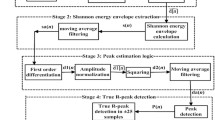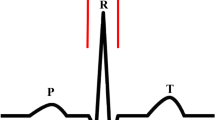Abstract
In this paper, we present a reliable and efficient automatic R-wave detection based on new nonlinear transformation and simple peak-finding strategy. The detection algorithm consists of four stages. In the first stage, the bandpass filtering and differentiation operations are used to enhance QRS complexes and to reduce out-of-band noise. In the second stage, we introduce a new nonlinear transformation based on energy thresholding, Shannon energy computation, and smoothing processes to obtain a positive-valued feature signal which includes large candidate peaks corresponding to the QRS complex regions. The energy thresholding reduces the effect of spurious noise spikes from muscle artifacts. The Shannon energy transformation amplifies medium amplitudes and results in small deviations between successive peaks. Therefore, the proposed nonlinear transformation is capable of reducing the number of false-positives and false-negatives under small-QRS and wide-QRS complexes and noisy ECG signals. In the third stage, we propose a simple peak-finding strategy based on the first-order Gaussian differentiator (FOGD) that accurately identifies locations of candidate R-peaks in a feature signal. This stage computes convolution of the smooth feature signal and FOGD operator. The resultant convolution output has negative zero-crossings (ZCs) around the candidate peaks of feature signal due to the anti-symmetric nature of the FOGD operator. Thus, these negative ZCS are detected and used as guides to find locations of real R-peaks in an original signal at the fourth stage. Unlike other existing algorithms, the proposed algorithm does not use search back algorithm and learning phase. The proposed algorithm is validated using the standard MIT-BIH arrhythmia database and achieves an average sensitivity of 99.94% and a positive predictivity of 99.96%. Experimental results show that the proposed algorithm outperforms other existing algorithms in case of different QRS complex morphologies (negative, low-amplitude, wide), very big change in amplitudes of adjacent R-peaks, irregular heart rates, and noisy ECG signals.












Similar content being viewed by others
References
Abdelliche, F., and A. Charef. R-peak detection using a complex fractional wavelet. In: International Conference on Electrical and Electronics Engineering, Bursa, 2009, pp. 267–270.
Abibullaev, B., and H. D. Seo. A new QRS detection method using wavelets and artificial neural networks. J. Med. Syst. 2010. doi:10.1007/s10916-009-9405-3.
Adnane, M., Z. Jiang, and S. Choi. Development of QRS detection algorithm designed for wearable cardiorespiratory system. Comput. Methods Programs Biomed. 93(1):20–31, 2009.
Arzeno, N. M., Z.-D. Deng, and C.-S. Poon. Analysis of first-derivative based QRS detection algorithms. IEEE Trans. Biomed. Eng. 55(2):478–484, 2008.
Benitez, S., P. A. Gaydecki, A. Zaidi, and A. P. Fitzpatrick. The use of the Hilbert transform in ECG signal analysis. Comput. Biol. Med. 31:399–406, 2001.
Biel, L., O. Pettersson, L. Philipson, and P. Wide. ECG analysis: a new approach in human identification. IEEE Trans. Instrum. Meas. 50(3):808–812, 2001.
Chen, Y. L., and H. L. Duan. A QRS complex detection algorithm based on mathematical morphology and envelope. In: Proceedings of 27th Annual International Conference of the IEEE EMBS, Shanghai, China, 2005, pp. 4654–4657.
Darrington, J. Towards real time QRS detection: a fast method using minimal pre-processing. Biomed. Signal Process. Control 1:169–176, 2006.
Elgendi, M., M. Jonkman, and F. De Boer. R wave detection using Coiflets wavelets. In: IEEE 35th Annual Northeast Bioengineering Conference, Boston, MA, 2009, pp. 1–2.
El-Segaier, M., O. Lilja, S. Lukkarinen, L. Srnmo, R. Sepponen, and E. Pesonen. Computer-based detection and analysis of heart sound murmur. Ann. Biomed. Eng. 33(7):937–942, 2005.
Gerencsr, L., G. Kozmann, and H. K. Zsuzsanna. The use of the SPSA method in ECG analysis. IEEE Trans. Biomed. Eng. 49(10):1094–1101, 2002.
Ghaffari, A., H. Golbayani, and M. Ghasemi. A new mathematical based QRS detector using continuous wavelet transform. Comput. Electr. Eng. 34:81–91, 2008.
Hadj Slimane, Z.-E., and A. Nait-Ali. QRS complex detection using empirical mode decomposition. Digit. Signal Process. Rev. J. 20(4):1221–1228, 2010.
Hamilton, P. S., and W. J. Tompkins. Quantitative investigation of QRS detection rules using the MIT/BIH arrhythmia database. IIEEE Trans. Biomed. Eng. 33:1157–1165, 1986.
Hongyan, X., and H. Minsong. A new QRS detection algorithm based on empirical mode decomposition. In: Proceedings of the 2nd International Conference on Bioinformatics and Biomedical Engineering, 2008, pp. 693–696.
Huang, B., and Y. Wang, Detecting QRS complexes of two-channel ECG signals by using combined wavelet entropy. In: International Conference on Bioinformatics and Biomedical Engineering, Beijing, China, 2009, pp. 1–4.
Hughes, N. P. Probabilistic models for automated ECG interval analysis. PhD thesis, University of Oxford, 2006.
Kadambe, S., R. Murray, and G. F. B. Bartels. Wavelet transform-based QRS complex detector. IEEE Trans. Biomed. Eng. 46(7):838–848, 1999.
Karvounis, E. C., M. G. Tsipouras, D. I. Fotiadis, and K. K. Naka. An automated methodology for fetal heart rate extraction from the abdominal electrocardiogram. IEEE Trans. Inf. Technol. Biomed. 11(6):628–638, 2007.
Khler, B.-U., C. Hennig, and R. Orglmeister. The principles of software QRS detection. IEEE Eng. Med. Biol. Mag. 21:42–57, 2002.
Kligfield, P., L. S. Gettes, and J. J. Bailey. Recommendations for the standardization and interpretation of the electrocardiogram: part I. The electrocardiogram and its technology: a scientific statement from the American Heart Association Electrocardiography and Arrhythmias Committee, Council on Clinical Cardiology; the American College of Cardiology Foundation; and the Heart Rhythm Society endorsed by the International Society for Computerized Electrocardiology. Heart Rhythm 4(3):394–412, 2007.
Li, C., C. Zheng, and C. Tai. Detection of ECG characteristic points using wavelet transforms. IEEE Trans. Biomed. Eng. 42:21–28, 1995.
Martnez, J. P., R. Almeida, S. Olmos, A. P. Rocha, and P. Laguna. A wavelet-based ECG delineator: evaluation on standard databases. IEEE Trans. Biomed. Eng. 51(4):570–581, 2004.
Meyer, C., J. F. Gavela, and M. Harris. Combining algorithms in automatic detection of QRS complexes in ECG signals. IEEE Trans. Inf. Technol. Biomed. 10(3):468–475, 2006.
Pahlm, O., and L. Srnmo. Software QRS detection in ambulatory monitoring—a review. Med. Biol. Eng. Comput. 22:289–297, 1984.
Pan, J., and W. J. Tompkins. A real time QRS detection algorithm. IEEE Trans. Biomed. Eng. 32(3):230–236, 1985.
Prasanna, S. R. M., and A. Subramanian. Finding pitch markers using first order Gaussian differentiator. In: IEEE Proceedings of the Third International Conference on Intelligent Sensing Information Process, 2005, pp. 140–145.
Romero, L., P. S. Addison, and N. Grubb. R-wave detection using continuous wavelet modulus maxima. IEEE Proc. Comput. Cardiol., 30:565–568, 2003.
Sabarimalai Manikandan, M., and S. Dandapat. Wavelet threshold based TDL and TDR algorithms for real-time ECG signal compression. Biomed. Signal Process. Control 3:44–66, 2008.
Sabarimalai Manikandan, M., and S. Dandapat. A novel method for detecting R-peaks in eletrocardiogram (ECG) signal. Biomed. Signal Process. Control, 2011. doi:10.1016/j.bspc.2011.03.004.
Surez, K. V., J. C. Silva, Y. Berthoumieu, P. Gomis, and M. Najim. ECG beat detection using a geometrical matching approach. IEEE Trans. Biomed. Eng. 54(4):485–489, 2007.
Tang, J., X. Yang, J. Xu, Y. Tang, Q. Zou, and X. Zhang. The algorithm of R Peak detection in ECG based on empirical mode decomposition. In: Fourth International Conference on Natural Computation, 2008, Vol. 5, pp. 624–627.
Thakor, N. V., J. G. Webster, and W. J. Tompkins. Estimation of QRS complex power spectra for design of a QRS filter. IEEE Trans. Biomed. Eng. 31:702–706, 1984.
Trahanias, P. E. An approach to QRS complex detection using mathematical morphology. IEEE Trans. Biomed. Eng. 40(2):201–205, 1993.
Y.-C. Yeha, and W.-J. Wanga. QRS complexes detection for ECG signal: the difference operation method. Comput. Methods Programs Biomed. 91:245–254, 2008.
Zhang, F., and Y. Lian. QRS detection based on multi-scale mathematical morphology for wearable ECG devices in body area networks. IEEE Trans. Biomed. Circuits Syst. 3(4):220–228, 2009.
Zhang, F., and Y. Lian. QRS detection based on morphological filter and energy envelope for applications in body sensor networks. J. Signal Process. Syst., 2009. doi:10.1007/s11265-009-0430-8.
Zhu, W., H. Zhao, and X. Chen. A new QRS detector based on empirical mode decomposition. In: IEEE 10th International Conference on Signal Processing (ICSP), 2010, pp. 1–4.
Acknowledgments
The authors would like to thank Editor-in-Chief, for his continuous encouragement and the anonymous referees for their valuable suggestions and comments.
Author information
Authors and Affiliations
Corresponding author
Additional information
Associate Editor Ajit P. Yoganathan oversaw the review of this article.
Rights and permissions
About this article
Cite this article
Kathirvel, P., Sabarimalai Manikandan, M., Prasanna, S.R.M. et al. An Efficient R-peak Detection Based on New Nonlinear Transformation and First-Order Gaussian Differentiator. Cardiovasc Eng Tech 2, 408–425 (2011). https://doi.org/10.1007/s13239-011-0065-3
Received:
Accepted:
Published:
Issue Date:
DOI: https://doi.org/10.1007/s13239-011-0065-3




